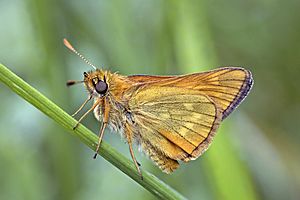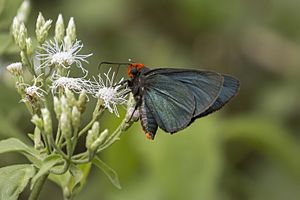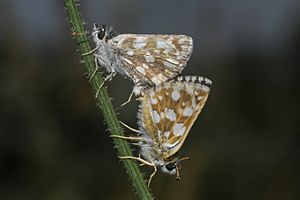Skipper (butterfly) facts for kids
Quick facts for kids Skipper |
|
|---|---|
 |
|
| Ochlodes sylvanus | |
| Scientific classification |
|
| Kingdom: | Animalia |
| Phylum: | Arthropoda |
| Class: | Insecta |
| Order: | Lepidoptera |
| Superfamily: | Papilionoidea |
| Family: | Hesperiidae Latreille, 1809 |
| Type species | |
| Hesperia comma Linnaeus, 1758
|
|
| Diversity | |
| 12 subfamilies, about 550 genera | |
Skippers are a special group of butterflies. They belong to the family Hesperiidae. This family is part of the larger group of insects called Lepidoptera. This group includes both moths and butterflies. Skippers get their name from how they fly. They have a very quick, darting flight style.
Most skippers have unique antennae. Their antenna tips are narrow and hook-like. There are over 3,500 known species of skippers. You can find them all over the world. However, most kinds live in the Neotropical areas. These areas include Central and South America.
Contents
What Makes Skippers Special?
Skippers are different from other butterflies. Scientists used to think they were in their own group. This group was called Hesperioidea. Now, most scientists place them with other butterflies. They are part of the butterfly group called Papilionoidea.
How Skippers Look Different
Skippers share many features with other butterflies. This is true for their eggs, larvae (caterpillars), and pupae. But skippers have special antennae. Their antennae have clubs that hook backward. They look a bit like a crochet hook. Regular butterflies have straight, club-like antennae. Moth-butterflies have feathery antennae, like many moths.
Skippers also have strong, thick bodies. Their compound eyes are usually larger than other butterflies. They have powerful wing muscles in their plump thorax. This makes them look more like moths in some ways. However, their wings are usually small compared to their bodies. Other butterflies often have much larger wings.
How Skippers Rest
When skippers are resting, they usually hold their wings in a special way. They often angle them upwards. Sometimes they spread them out flat. They rarely fold their wings completely closed.
Skipper wings are usually rounded. Their front wings often have sharp tips. Some skippers have long tails on their back wings. But overall, their wing shapes don't change much. They are not as varied as other butterflies.
Most skippers have plain colors. They are often browns and greys. Some have bold black and white patterns. Yellow, red, and blue colors are less common. But some brown species can be very colorful. You usually won't see green or shiny metallic colors on skippers.
Spotting Differences Between Skippers
It can be very hard to tell some skipper species apart. For example, some skippers in the groups Amblyscirtes, Erynnis (called duskywings), and Hesperia (called branded skippers) look almost identical. Even experts can't tell them apart just by looking. The only sure way to identify them is to study their tiny body parts under a microscope.
Skipper Family Groups
There are about 3,500 species of skippers. Scientists group them into these subfamilies:
- Katreinae
- Coeliadinae – These are called awls, awlets, and policemen. There are about 75 species.
- Euschemoninae – This group has only one species, the regent skipper.
- Eudaminae – These are dicot skippers.
- Chamundinae
- Pyrginae – These include spread-winged skippers and firetips.
- Tagiadinae
- Heteropterinae – These are called skipperlings. There are about 150 species.
- Hesperiinae – These are grass skippers. This is the largest group, with over 2,000 species.
- Megathyminae – These are giant skippers. There are about 18 species. Some scientists think they might be part of Hesperiinae.
- Barcinae
- Trapezitinae – These are Australian skippers. There are about 60 species.
See also
 In Spanish: Hespéridos para niños
In Spanish: Hespéridos para niños




